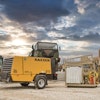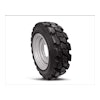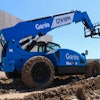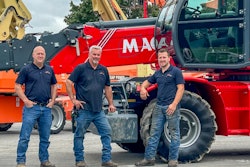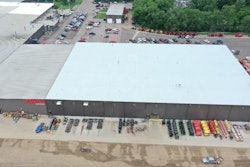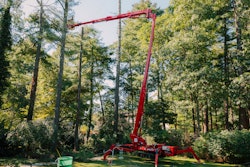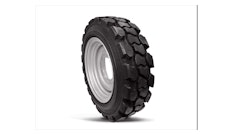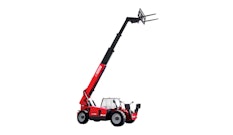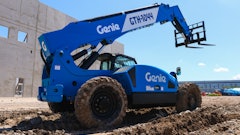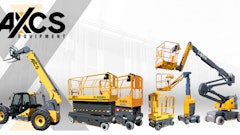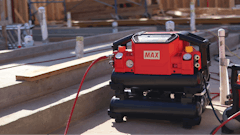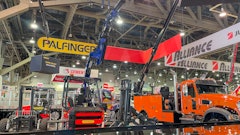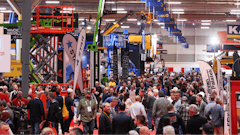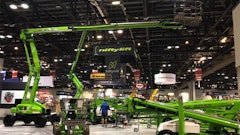
As you already know, mobile elevating work platforms (MEWPs) are indispensable in countless industries to complete construction, maintenance, and various industrial tasks that require temporary work at height to be performed efficiently and safely. However, all work at height comes with inherent risks. These risks, and the hazards associated with these risks, are addressed and can be successfully mitigated through the development of comprehensive industry standards governing MEWP design, manufacturing practices, operation, and maintenance. IPAF and its members play a key role in establishing international standards developed by ISO (International Organization for Standardization) and National standards, such as those developed by the ANSI (American National Standards Institute) through the SAIA (Scaffold and Access Industry Association), along with Canadian standards developed by the SCC (Standards Council of Canada) through the CSA, (Canadian Standards Association). These voluntary consensus standards focus on three key areas: design, safe-use, and training.
Though the ultimate goal would be to have a single standard for MEWPs that would cover each of these key areas and that this single standard would be accepted globally, the reality is that each region and many times even neighboring countries have laws, rules or best practices that do not align with a single standard approach. The result is having multiple standards on the same subject for the same machines. For this reason, IPAF staff and members have to be actively engaged in standards development work on many fronts. As they say, “it takes a village” and this is where IPAF, through its staff and member expert participation, and using its collective voice, can heavily influence the standards development process. Since the ultimate goal does not seem to be attainable, the realistic goal is to develop harmonized standards that establish the best standards requirements possible, both regionally and internationally.
Accomplishing this goal takes substantial financial and personnel resources which IPAF is committed to providing on behalf of its members for the long-term. It also takes IPAF member company involvement by providing the needed expertise to write these standards. Since IPAF staff have taken leadership and subcommittee roles with many of the standard’s bodies, they help advise, mentor, and guide members who want to participate in this important work.
Leadership
IPAF North America staff currently are serving in the following leadership roles.
On ISO/TC 214/WG 1:
- Dan Moss serves as the WG 1 Secretary and Document Editor
- Tony Groat and Dan Moss also serve as subject matter experts for the ISO 16368, ISO 18878, ISO 18895, and ISO 21455 Projects.
- Tony Groat is the Project Leader for the ISO 18893 project.
On the ANSI/SAIA A92.22 and A92 Harmonized Definitions Sub-Committee: Tony Groat is serving as Chair. He is also a member of the A92.20 and A92.24 Sub-Committees. Dan Moss is a member of the A92.2, (aerial devices) A92.9 and A92.10 (mast climbers) as well as A92.20, A92.22 and A92.24.
On the CSA/B354 Committees: Tony Groat serves as the Co-Chair of the CSA/B354 Main Committee while also serving as the Subcommittee Chair of the CSA/B354.7 and CSA/B354.8 Sub-Committee and a member of CSA/B354.6.
U.S. ANSI/SAIA A92 Suite
After dealing with appeals to address prior language identified as commercial terms violations by an ANSI Review Board, the latest ANSI/SAIA 92.20 MEWP design standard and ANSI/SAIA A92.22 safe-use standard was published on August 15, 2021, and became effective on the day of publication. ANSI/SAIA 92.24 (training) standard was published on December 20, 2018, but due to the appeals filed on the related design and safe-use standards, it did not become effective until June 1, 2020.
Typically, after a standard is published, ANSI requires standards to undergo periodic maintenance, defined as the review of the entire document and action to revise or reaffirm it on a schedule not to exceed five years from the date of its approval. Standard development work is NEVER done!
Currently, all three of these A92 standards are going through the maintenance revision process with hope that each will be submitted for approval vote this fall. If approved by the A92 consensus body, these standards will go through additional months of procedures to achieve final ANSI approval and publication. Each of these standards was essentially last edited in 2018 as later publications were limited to appeal language revisions. Also, the ISO MEWP standards are currently under revision, and they are the basis for the ANSI A92 standards. Good information sharing and proposal-making has been taking place between committees in hopes of aligning the documents.
 @markobe - stock.adobe.com
@markobe - stock.adobe.com
Other ANSI/SAIA A92 Standards: USA
ANSI/SAIA A92.2, which covers vehicle-mounted aerial devices, was published in 2021 to address the same identified commercial term violation language across the A92 standards. With the 5-year clock always ticking, the standard is in maintenance with a plan for a revision in the coming years. A92.2 will remain independent of the A92 Suite of Standards (A92.20, A92.22, A92.24).
ANSI/SAIA A92.7, for airport support vehicles, was to be published several years ago, but due to the distraction of the appeals, its republication stalled. It is now under a new chair and will hopefully move to being republished in late 2025.
ANSI/SAIA A92.9, for mast climbing work platforms, was published in 2023. Shortly after publication, the A92.9 committee submitted a proposal to the A92 Main Committee to split the committee into two parts. This proposal was approved and now ANSI/SAIA A92.9-1 will be responsible for developing a new standard covering the design aspects of MCWPs and ANSI/SAIA A92.9-2 will cover the safe use and training aspects of MCWPs.
ANSI/SAIA A92.10, for transport platform work platforms, was published in 2023. Similar to the A92.9 standard, the A92.10 committee submitted a proposal to the A92 Main Committee to split the committee into two parts. This proposal was approved and now ANSI/SAIA A92.10-1 will be responsible for developing a new standard covering the design aspects of MCWPs and ANSI/SAIA A92.10-2 will cover the safe use and training aspects of MCWPs.
CSA/B354 Suite: Canada
The Canadian B354 standards went into effect in May 2018 and are adoptions of ISO MEWP standards for design, safe-use, and training, with added Canadian deviations. As adoptions of ISO standards, the CSA B54 committees are waiting for corresponding ISO MEWP standards to be republished before starting a review process on CSA/B354.5 (design), CSA/B354.6 (safe use) and CSA/B354.7 (training). This review will likely be started in late 2024 or early 2025 after the ISO standards have been published.
ISO/TC 214 Standards: International
ISO Technical Committee 214 (elevating work platforms) was formed in late 1996 to develop standards related to mobile elevating work platforms (MEWPs) as well as mast climbing work platforms (MCWPs). ISO/TC 214 currently has 19 Participating/voting (P) countries and 19 Observing (O) Countries actively engaged in its work.
ISO/TC 214 currently has 9 published International Standards including:
- ISO 16368, Mobile elevating work platforms – Design, calculations, safety requirements, and test methods This standard was published in 2010 and was last reviewed and confirmed in 2021, making this version current. A new final draft is being processed and is targeted for publication in late 2024.
- ISO 16369, Mast-climbing work platforms (Under study. Potential revision to better align with ANSI A92.9 and other regional standards.)
- ISO 16653-1, Mobile elevating work platforms – Design, calculations, safety requirements, and test methods relative to special features – Part 1: MEWPs with retractable guardrail systems (Intention is to withdraw this standard once ISO 16368 is published as the requirements have been incorporated into ISO 16368.)
- ISO 16653-2, Mobile elevating work platforms – Design, calculations, safety requirements and test methods relative to special features – Part 2: MEWPs with non-conductive (insulating) components
- ISO 16653-3, Mobile elevating work platforms – Design, calculations, safety requirements, and test methods relative to special features – Part 3: MEWPs for orchard operations
- ISO 18878, Mobile elevating work platforms – Operator (driver) training (New revision to be published in early 2025.)
- ISO 18893, Mobile elevating work platforms – Safety principles, inspection, maintenance, and operation (Final draft being processed. Should be published in late 2024.)
- ISO 20381, Mobile elevating work platforms – Symbols for operator controls and other displays
- SO 21455, Mobile elevating work platforms – Operator’s controls – Actuation, displacement, location, and method of operation
ISO/TC 214 currently has one proposed project:
- ISO 24995, Mobile elevating work platforms – Overhead obstruction detection systems and secondary guarding (2nd new proposal to be submitted by Standards Australia in May 2024)
![Tony Groat Edited 5b57430ec070e[1] Headshot](https://img.forconstructionpros.com/files/base/acbm/fcp/image/2024/06/Tony_Groat_edited.5b57430ec070e_1_.667c30792412c.png?auto=format%2Ccompress&crop=faces&fit=crop&h=48&q=70&w=48)
